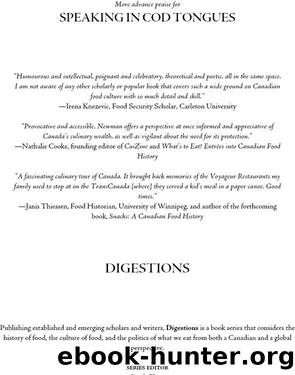Speaking in Cod Tongues by Lenore Newman

Author:Lenore Newman
Language: eng
Format: epub
Publisher: University of Regina Press
Published: 2016-11-14T16:00:00+00:00
8
Alberta and British Columbia
Alberta
Alberta is a vast landscape of open prairie, eroded badlands, northern boreal forest, and soaring mountains. Famous—or infamous—for the oil and bitumen extraction that has drawn hundreds of thousands of workers and raised the ire of environmentalists, Alberta is driven by the paradoxical combination of resource extraction and tourism. It is one of only two provinces without a coastline, and historically it had strong ties to the American west. The stereotypical association of Alberta with cowboy culture, right-leaning political views, and stronger religious affiliations still has some grounding in reality, but today’s Alberta is a cosmopolitan place, with 80 per cent of its citizens living in the Calgary-Edmonton corridor. In most previous explorations of Canada’s cuisine, Alberta has been included with the other two prairie provinces, but this is no longer a sufficient way to encapsulate the diversity and robustness of the foods found there. Alberta has been a wealthy province, both from its oil and from its international visitors, who have come for the high mountain resorts and the foothills ranching culture, and this wealth has driven a unique cuisine that embraces both prairie and mountain. I call this culinary style big sky cuisine.
It begins with beef. The Alberta cattle industry produces 60 per cent of Canada’s beef, and local chefs highlight the province’s high-quality cattle. Steak is the most popular beef preparation in the province, but Alberta is also a great place to find a high-end hamburger. Cattle were introduced to the province in 1876 from the United States, and from the beginning the industry was successful, for the land that once supported vast herds of bison was well suited to supporting cows. As Henry Klassen has explored,1 ranches were often medium to small in size and owner-occupied. Entrepreneurial in its scope, the industry helped to feed the raging demand for beef in Britain; export has always been a large part of the Alberta industry. Today Alberta has roughly 5 million head of cattle, and 31 per cent of the province’s farmland is pasture. The story of beef, however, is also a story of excellence in marketing and lobbying. Blue captures this well in her 2008 essay “If It Ain’t Alberta, It Ain’t Beef,” which explains Alberta beef culture as an outgrowth of the province’s sense of exceptionalism, a feeling that the rest of Canada doesn’t understand or value the west and its way of life. James Careless, who gave us the best insight into the life of George Brown, explored this concept as an example of core-periphery power relations deeply rooted in Canada’s historical development. Because political power in Canada rested in Ontario and Quebec, Alberta was an agrarian outlier, always feeling slightly excluded and misunderstood.2 By the late 1980s, ongoing resentment in the region led to the rise of the Alberta-based Reform Party, a federal political party that campaigned on the slogan “The West Wants In.” By the time Calgary hosted the 1988 Winter Olympics, the mood was right for the emergence of a distinct identity for Alberta.
Download
This site does not store any files on its server. We only index and link to content provided by other sites. Please contact the content providers to delete copyright contents if any and email us, we'll remove relevant links or contents immediately.
| African | Asian |
| Canadian | Caribbean & West Indian |
| European | International |
| Latin American | Mexican |
| Middle Eastern | Native American |
| U.S. Regional |
Biscuits: A Savor the South Cookbook by Belinda Ellis(3906)
Al Roker's Hassle-Free Holiday Cookbook by Al Roker(3178)
A Jewish Baker's Pastry Secrets: Recipes from a New York Baking Legend for Strudel, Stollen, Danishes, Puff Pastry, and More by George Greenstein(3105)
Ottolenghi Simple by Yotam Ottolenghi(3039)
Trullo by Tim Siadatan(2989)
The French Women Don't Get Fat Cookbook by Mireille Guiliano(2984)
Better Homes and Gardens New Cookbook by Better Homes & Gardens(2954)
Bake with Anna Olson by Anna Olson(2933)
Panini by Carlo Middione(2828)
Hot Thai Kitchen by Pailin Chongchitnant(2810)
Nigella Bites (Nigella Collection) by Nigella Lawson(2775)
Momofuku by David Chang(2763)
Modern French Pastry: Innovative Techniques, Tools and Design by Cheryl Wakerhauser(2724)
Salt, Fat, Acid, Heat: Mastering the Elements of Good Cooking by Nosrat Samin(2658)
Tapas Revolution by Omar Allibhoy(2537)
Classic by Mary Berry(2501)
Solo Food by Janneke Vreugdenhil(2494)
Best of Jane Grigson by Jane Grigson(2468)
Okonomiyaki: Japanese Comfort Food by Saito Yoshio(2390)
